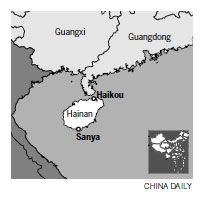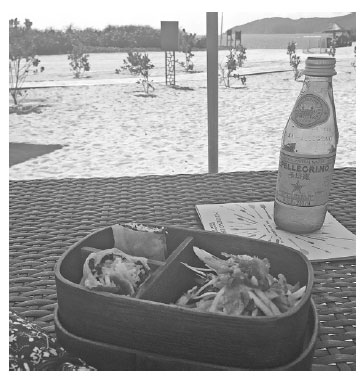The offerings for those looking for a laid-back holiday are proving to be irresistible
A duty-free shopping policy text message popped up the minute I switched on my mobile phone straight after I landed at Sanya Phoenix International Airport in Hainan province.
A few minutes later, after learning I would be exempted from tax here without leaving the country, I was pondering whether to fork out a few thousand yuan for sunglasses and cosmetics at the Sanya International Duty-Free Shopping Complex.
I rang my girlfriend and asked her if the items I had my eyes on were as cheap as they seemed to be. Her answer was an emphatic yes, so I pulled out my credit card and swiped it.
The southern island province raised the duty-free spending limit for non-locals to 16,000 yuan ($2,470) a year on Feb 1. Previously such purchases were limited to two a year of 8,000 yuan each.
The move has given potential tourist one more reason to visit the island, in addition to its sunny weather, attractive beaches and laid-back pace of life.
Duty-free sales hit 340 million yuan during the week-long Spring Festival holiday, customs sources say. The range of products has also expanded to 37 from just a few earlier.
"Some cosmetics are even cheaper than in Hong Kong," says Wang Keqiang, deputy director-general of the Hainan provincial commerce department.
In Hainan, watch brands such as Tissot and Longines have long enjoyed the best sales of any place on the planet, Wang says.
The State Council also recently adopted a measure allowing non-locals who leave the island by train to enjoy the rebate, says Wang; it was previously limited to those leaving by air.
As a result, Wang says, he expects tourist spending this year to rise 30 percent, to between 6 billion yuan and 7 billion yuan.
The improved duty-free shopping is just one of many measures Hainan has taken to transform itself into an international destination.
By 2020 the island province aims to attract more than 80 million tourists, including 1.2 million from overseas, and total tourism revenue is projected to surpass 100 billion yuan.
The number of tourists who spent at least a night in Sanya reached 15 million last year, the local government says.
The government has also developed sea tours along the eastern line of the province, forest-themed trips in the middle and port and industry outings in the west, Wang says.
More road trips will be launched as Hainan develops camp sites for self-drive tourists, a concept that is now being developed.
China's biggest caravan and camping forum will be held in the province in September and is expected to draw many self-drive associations from around the country to look at what Hainan has to offer, Wang says.
A total of 100 industry towns and 1,000 distinctive villages will be established over 2016-2020 to woo Chinese tourists.
The town of Huiwen, for instance, has attracted many visitors for its handmade wooden Buddhism beads and has pulled in several hundred million of yuan annually.
"Tourists find it fascinating to see local households use small equipment to make the beads," Wang says.
Local food is also offered at major events, such as the Boao Forum, to enable guests worldwide to savor the flavors of Hainan.
Qilou Old Street in Haikou has brought together 100 restaurants that offer practically all distinctive local cuisines and it has become a tourist magnet.
Sanya's priority is developing its tourism, says Li Boqing, deputy mayor of the city.
At the first annual Hainan International Tourism Trade Expo, held in Sanya on March 26, agreements on 71 tourism-related projects worth 13.2 billion yuan investments were signed. As part of the expo, a duty-free goods fair at which nearly 200 international brands were represented was held.
Companies from India, Italy, France, Malaysia, Myanmar, Pakistan, Poland, South Korea, Thailand and Vietnam took park in the weeklong event, hosted by the local city and provincial governments, the central Commerce Ministry and the national body China Council for the Promotion of International Trade.
Well-known artists from home and abroad were invited, the aim being to raise the expo's profile among art lovers.
"The aim is to strengthen communication with the international community and encourage more visits from abroad with better services," says Li.
At the expo, many tourism operators displayed their offerings, while seeking potential business collaboration.
The aviation operator Meiya Air Co, which offers sightseeing tours and flight training in Hainan, plans to triple its fleet this year, acquiring four new seaplanes to cater to increasing demand, says Xu Yan, the company's key account manager.
It has about 3,000 customers a year, she says.
Hainan also plans to expand duty-free shopping zones, improve international transport and stage more tourism activities, a local government report says. The government is now working on hosting a global luxury conference to Sanya next year that is expected to draw in more brands to the island.
Meanwhile, the new Boao Airport, designed to handle 480,000 passengers a year by 2020, opened last month.
Airports at Haikou and Sanya will also be expanded this year, and another will be built in Danzhou in the next three years, the local government report says.
"We will put on new international flights at the new Boao airport," Wang says.
There are now direct flights to Hainan from Beijing, Shanghai and Guangzhou and Shenzhen in Guangdong province.
This year more flights to and from Hong Kong and Singapore have been introduced, he says.
The trans-island high-speed rail has made things easier for travelers to move around Hainan, especially to enjoy the port and industry tours that are being promoted.
The Sanya government is also talking with Uber, the car sharing app developer, about the possibility of working together. Many foreigners are used to Uber, and the introduction of its software will make getting around Hainan easier, Li says.
Government officials have also been working to make tax rebates more attractive for international travelers. Because Hainan has very few international flight connections, few international travelers are eligible to claim tax rebates because few leave the country from Hainan.
Wang has proposed that international air travelers who have bought duty-free goods in Hainan be eligible for tax rebates if they leave the country from Shanghai or Beijing.
"That policy might come into force fairly soon," Wang says.
Improved infrastructure has helped the island appeal to a growing number of conventions and exhibition attendees. The island now has 68 five-star hotels, says Li Xuefeng, deputy director of the convention and exhibition bureau with the provincial commerce department.
"They are mostly along the coastline and tropic forests, making them ideal for such visitors."
Last year, conventions and exhibition tourists made 2.8 million visits to Hainan, up 13 percent year on year.
"The first and fourth quarters are the most popular seasons for such guests," Li says.
During my short stay at Dadonghai beach, many foreigners were sunbathing or in the water, a clear indication that the effort to draw international travelers to the island is already paying off.
yangfeiyue@chinadaily.com.cn
|
Hainan province is famous for its beautiful beaches and dutyfree shopping. Photos By Liu Zhihua / China Daily |


(China Daily 04/09/2016 page17)
